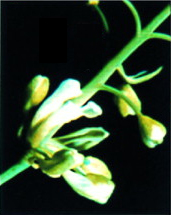Floral Reversion
Sometimes, flowers revert back to shoots (vegetative growth) after they have started to be formed. This is called floral reversion.
Floral reversion is a rare phenomenon in nature, but can be stimulated in some plants in the laboratory.
Floral reversion is the process where the floral meristem reverts back to an inflorescence meristem or even a vegetative meristem, causing an inflorescence or shoot to emerge from the developing flower.
Floral reversion requires a change in the identity of a meristem. A meristem undergoes several phase changes (starting with a juvenile phase) and this is controlled by particular genes such asLEAFY in Arabidopsis. In floral reversion, this process is reversed.

In agamous mutants of Arabidopsis thaliana, floral reversion can be induced by altering the photoperiod (Okamuro et al. 1996). Arabidopsis plants heterozygous with the LEAFY gene can also be induced to undergo floral reversion using the same conditions.
Other mutants in other genera have also been identified that control floral reversion, and under specific conditions using the appropriate mutants, floral reversion can be stimulated. This often involves the use of gibberellins.
Next: The Potassium Myth
